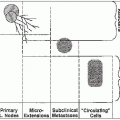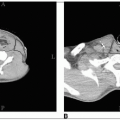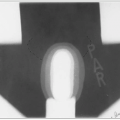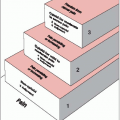Wilms’tumor is often localized at diagnosis. It is curable in most children.
Spread may occur throughout the peritoneal cavity, especially if there has been preoperative rupture or the disease has been spilled at surgery. However, the results of the Second National
Wilms’ Tumor Study (NWTS-2) demonstrated that tumor spillage at surgery, when localized to the flank, is less important prognostically than formerly believed (6, 11).
The lungs are the most common metastatic site, followed by the liver. In NWTS-2, 57 patients (11.4%) had metastases at diagnosis; 47 of these had pulmonary metastases only (6).
Poor prognosis is seen in patients with extensive tumors, diploid tumors, unfavorable (anaplastic) histology, and chromosomal loss in 1p and 16q (15).
NWTS-2 showed the importance of lymph node involvement as a prognostic factor.
The classic presentation for Wilms’tumor is that of a healthy child in whom abdominal swelling is discovered by the child’s mother, pediatrician, or family practitioner during a routine physical examination.
A smooth, firm, nontender mass on one side of the abdomen is felt (17).
Gross hematuria occurs in as many as 25% of these cases.
The child may be hypertensive or have nonspecific symptoms, such as malaise or fever.
Only rarely does a patient present with symptomatic metastases.
Plain films of the abdomen may demonstrate calcifications, which occur in 60% to 70% of neuroblastomas and 15% of Wilms’tumors.
An excretory urogram (intravenous pyelogram) can differentiate renal tumor from other conditions. Cysts often appear as radiolucent areas.
Ultrasonography may be helpful because, in up to 10% of Wilms’tumor patients, the kidney cannot be seen on intravenous pyelogram.
Abdominal computed tomography (CT) delineates the intrarenal tumor and demonstrates gross extrarenal spread, lymph node involvement, liver metastases, and the status of the opposite kidney.
TABLE 46-1 Pretreatment Workup for Patients with Renal Mass Suspected of Wilms’ Tumor According to National Wilms’ Tumor Study No. 5 Recommendations | ||||||||||||||
|---|---|---|---|---|---|---|---|---|---|---|---|---|---|---|
| ||||||||||||||
A direct comparison of CT with ultrasonography suggests that CT is a better diagnostic tool overall.
Clinical and imaging impression does not obviate the need for inspection at laparotomy.
Plain chest radiography is essential. Chest CT may reveal some early lesions not visible on routine radiography, but it adds little when the chest radiographs are clearly positive.
A detailed discussion of the issues in diagnostic imaging has been published (1).
A complete blood count and urinalysis should be performed. Serum blood urea nitrogen and creatinine levels and liver function tests are routine.
If neuroblastoma is not ruled out, a test for urinary catecholamines should be performed.
Table 46-1 outlines the pretreatment investigations recommended in the NWTS-5.
Tumor staging is performed by carefully examining the operative and the histopathologic findings.
The most widely used staging system was devised by the NWTS (Table 46-2) (11), after analysis of NWTS-1 and NWTS-2 results, in which a grouping system had been used.
Prognosis is affected by which of the many variants of Wilms’tumor is present (21).
Although histopathologists had attempted to relate appearance to prognosis, no generally acceptable classification was available until the report of Beckwith and Palmer (3) from the NWTS-1.
TABLE 46-2 National Wilms’ Tumor Study Staging System | ||||||||||||||||||||||||||||||||||||
|---|---|---|---|---|---|---|---|---|---|---|---|---|---|---|---|---|---|---|---|---|---|---|---|---|---|---|---|---|---|---|---|---|---|---|---|---|
| ||||||||||||||||||||||||||||||||||||
The NWTS classifies all tumors as having favorable histology (FH) or unfavorable histology (UH) for purposes of treatment. Of 1,465 randomized patients on NWTS-3,163 (11.1%) had UH histology (5).
Renal cell carcinomas and congenital neuroblastic nephromas are not considered Wilms’ tumor.
Two monoplastic sarcomatous varieties are no longer considered true Wilms’tumors, but have been included in NWTS protocols (2).
Stay updated, free articles. Join our Telegram channel

Full access? Get Clinical Tree








